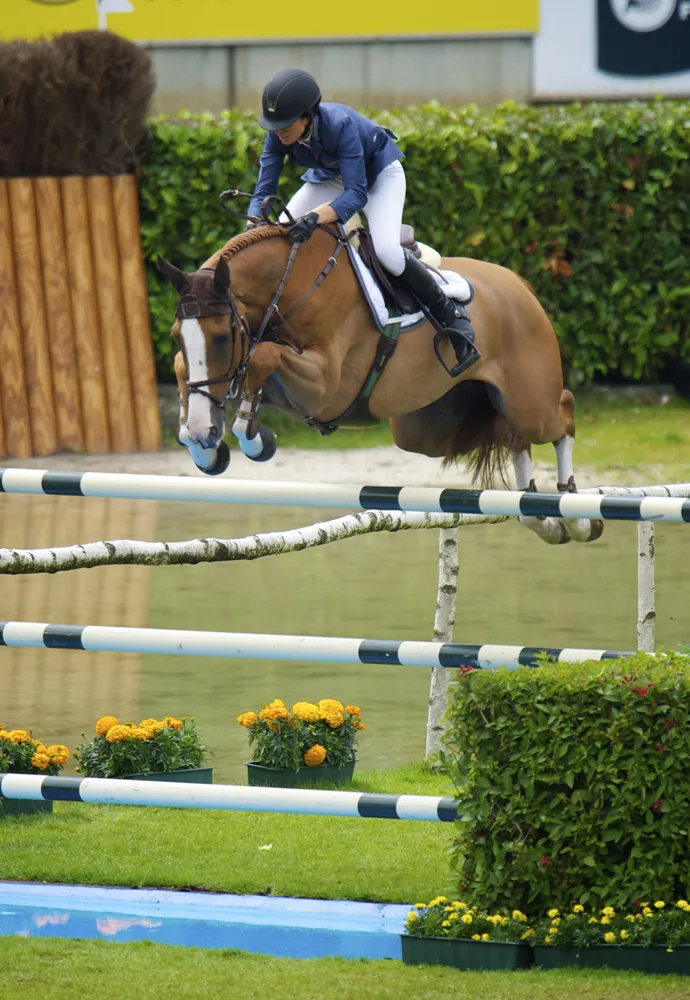I’m sure I’m not the only one whose eyebrows rose a bit when they read the news about Jan Tops acting as agent for the 11 million Euros purchase of Palloubet d’Halong, a 10-year-old gelding.
According to an online currency conversion tool, that makes the price tag in the neighborhood of $15 million ($14.8 million, in fact, but what’s a $100,000 or two when we’re in this stratosphere of penny-counting, right?). The mind boggles, reels, and does all kind of acrobatic feats.
I know there are plenty of Chronicle readers who have paid hefty sums for special equine creatures, but I’m sure there are a few more zeros on there than many have ever imagined paying. Remember, too, this is a gelding we’re talking about. Totilas’ sale in 2010 rocked the dressage world, but his breeding capability (and earning possibilities) as a stallion were obviously a major part of that decision.
One topic that comes up over and over again when I talk to top show jumpers is the absolute need for multiple top horses and the ridiculous cost of obtaining those horses. The days of the one-hit wonder are over; riders need a string of brilliant, exceptional horses to stay on top of the game. Every day, those brilliant, exceptional horses get more and more expensive. It’s not just the top ones who are becoming pricier; the inflated prices trickle down to the young stock as well.
It’s not just the daunting thought of purchasing one of those horses—the majority of U.S. show jumpers buy younger, more affordable horses that they hope will turn into one of those superstars. It’s the fact that if they buy a young prospect and develop it over years to become a clean-round-jumping machine, they’ll inevitably start getting offers they can’t refuse. And the sad reality of the horse world is that it very rarely makes sense to say no to selling a horse. So, young up and comers like Janika Sprunger wave goodbye to their championship medal hopes for the next few years as the horse van pulls out the driveway in a cloud of cash.
It’s happened to U.S. riders. Candice King has watched two horses she nurtured to the grand prix level—HH Rebozo and Davos—jump with other riders in international championships after being sold for goodly sums. It’s happened to New Zealand rider Katie McVean, who made her family’s homebred Dunstan Delphi into an international contender, coming sixth at the 2010 FEI World Cup Final and jumping at the 2010 Alltech FEI World Equestrian Games (Ky.).
In 2011, the McVean family finally got an offer they couldn’t refuse of $10 million from the Saudi Arabian Equestrian Federation. In an interview then with the New Zealand Herald, McVean voiced the bittersweet yin and yang of the decision: “There is still a small chance, but I think I am going to have to give up on my London [Olympics] dream and start over. It has been my goal for a long time but if I tried to keep her and everything had gone wrong, I would have had nothing—this way I can set up for the future, and maybe next time I won’t have to sell.”
ADVERTISEMENT
The United States was lucky that Abigail Wexner stepped in to save the day when Authentic was in danger of being sold abroad, and that McLain Ward was able to keep Sapphire in his barn through multiple ownership changes. And those horses rewarded those efforts with another Olympic team gold medal in 2008.
But even since then, prices for top horses have snowballed into sums that are almost impossible to dismiss. It’s happening in every discipline. U.S. dressage chef d’equipe Robert Dover just published a blog asking for U.S. breeders to promote their young stock to him in an effort to stock U.S. riders with homegrown talent because buying from Europe just isn’t sustainable.
Of course, there are good aspects to riders and owners getting such astronomical sums—you can buy a lot of young prospects for $15 million and, as McVean did, start over with your Olympic dreams. But it makes the top end of the sport ever more unattainable to the talented young rider who polishes a diamond in the rough horse into a star.
Janika spoke about the sale in an interview with Noelle Floyd: “It is good for sponsors. It is good for them to see that it is possible to get big money and it motivates sponsors in our sport. It has motivated my sponsor so much. He is more motivated now then ever before. For us riders, this is our life, we need the sponsors and we need their support. We can see the need for money but for us it isn’t just about the money. It can’t be. It is about the horses,” she said to Floyd.
So yes, there are definitely bright sides to this news. But I don’t know how much money in her pocket is going to comfort Janika as she watches his new rider jump Palloubet and possibly win medals on him, and then walks back to her barn full of 7- and 8-year-olds that she can only hope have a glimmer of his talent. She told Floyd, “I have many good horses, younger horses also, who I have big belief in and big hopes for but there is no chance that I will ever get a second Palloubet.”
Is it fair to ask our riders to choose between their horses of a lifetime and mountains of cash? Are we facing a future when it’s going to be impossible to play on the international level without spending multi-millions on horses? What’s the end game to this escalation of prices?















